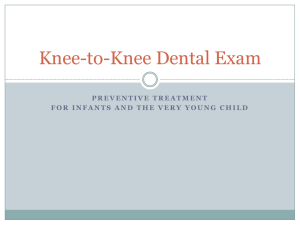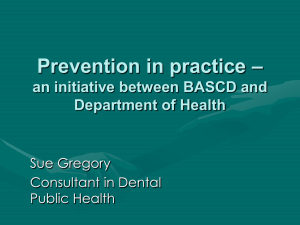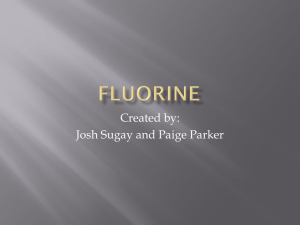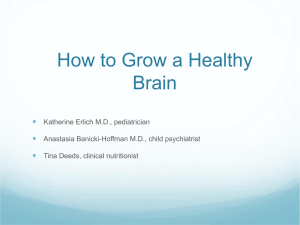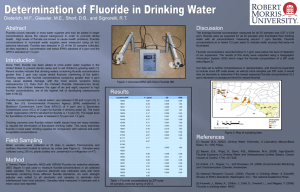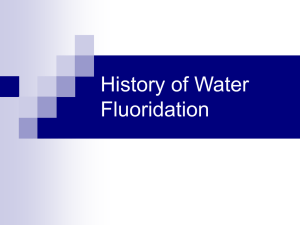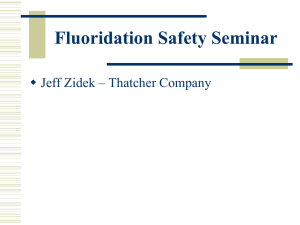Fluoride Sources
advertisement
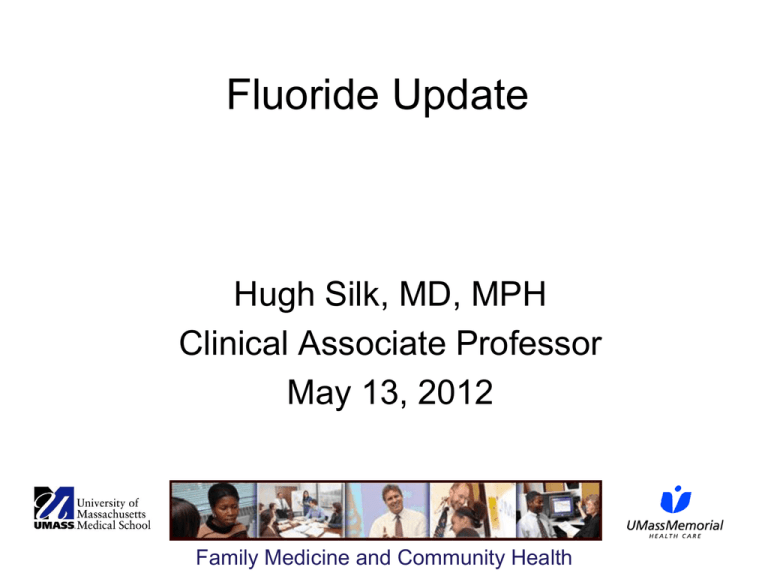
Fluoride Update Hugh Silk, MD, MPH Clinical Associate Professor May 13, 2012 Family Medicine and Community Health Learning Objectives By the end of this talk participants will be able to discuss: • Benefits of fluoride • Updates in – – – – fluoridated water levels fluoride prescribing Bottled water and fluoride mixing formula with fluoridated water • The benefits and process for providing fluoride varnish in your office Family Medicine and Community Health Acknowledgment: Some materials today are used from Smiles for Life 8 annotated 50 minute PowerPoint modules www.smilesforlifeoralhealth.org Family Medicine and Community Health 4 Disclosures • I have no relevant financial relationships with the manufacturer(s) of any commercial product(s) and/or provider(s) of commercial services discussed in this CME activity • I will be speaking about fluoride varnish as an off-label use product for caries prevention; it has been approved by US Food and Drug Admin as a cavity liner and treatment of sensitive teeth only; I will present evidence on proven benefit of product Family Medicine and Community Health A Reminder of the Benefits of Fluoride Family Medicine and Community Health Effects and Sources of Fluoride Topical Mechanisms (main effect) • Inhibiting tooth demineralization • Enhancing remineralization • Inhibiting bacterial metabolism Systemic Mechanisms • Reducing enamel solubility through incorporation into the tooth during development Fluoride Sources • Topical: • Dietary: Fluoride toothpastes Gels, foams, mouthwashes Fluoride varnish Water fluoridation Dietary fluoride supplements Photos: Joanna Douglass, BDS, DDS Family Medicine and Community Health 6 Evidence of Benefit 7 General Population (USPSTF 1989, 1996) • Fluoridated toothpaste (I, A) High Risk Populations (MMWR 2001) • Fluoride varnishes on permanent teeth (I, A) • Fluoride varnish on high risk infants (I, A) • Fluoride supplements if water <0.3ppm (6-12 year olds) (I, A) Cochrane Data Base (2006) • Fluoride varnishes on primary and permanent teeth (I,A) I: Indicates a recommendation is based on evidence from properly constructed randomized controlled trials A: Indicates a high certainty that net benefit is substantial Family Medicine and Community Health Fluoride Use Recommendations All children should receive fluoride through water fluoridation or fluoride supplements. No Family Medicine and Community Health 8 Fluorosis Appearance and Significance • White mottling of teeth due to chronic excessive exposure to fluoride during tooth development • Cosmetic issue Risk Reduction 9 Moderate Fluorosis Photo: Joanna Douglass, BDS, DDS • Determine fluoride content of drinking water before prescribing F Severe Fluorosis • Use current dosage schedules • Avoid duplicating fluoride prescriptions (e.g. 2,500 Head start children in MA take fluoride supplements daily) • Use only a smear of toothpaste Photo: John O'Donnell, DDS • Fluoride varnish does not cause fluorosis Family Medicine and Community Health Updates in: • fluoridated water levels • fluoride prescribing • Bottled water and fluoride • mixing formula with fluoridated water Family Medicine and Community Health Water fluoridation • CDC: 1 of top 10 public health achievements of the 20th century • Fluoride in water: colorless, odorless, tasteless • Fluoridation is cost effective: $1 spent saves $38 Communities with fluoridated water have less cavities (J Pub Health Dent 2010;70:227-33) • Removing F -> median increase of 18% caries (Am J Prev Med 2002;23(suppl:21-54)) • 65% of MA is receiving benefits of water fluoridation Family Medicine and Community Health Fluoridation levels • Department of Health and Human Services proposed setting its recommended level at 0.7 mg/L for benefits against tooth decay • Environmental Protection Agency 4 mg/L to avoid risks (fluorosis) • MA recommended fluoridation level: 0.91.2 ppm Family Medicine and Community Health http://www.mass.gov/eohhs/docs/dph/c om-health/fluoride-census.pdf Family Medicine and Community Health Bottled Water • • • • • • • 29 gallons per person annually Cultural variabilities: latino ↑ water=illness FDA does not require F level on bottle 5% list level; 80% have suboptimal level Different batches have different levels! Deionized, distilled, purified – no F (unless indicated) No studies comparing bottle water drinkers to consistent fluoridated water users Family Medicine and Community Health Family Medicine and Community Health Formula and Fluoridated Water • 61% of infants have received some formula by age 6 months (CDC) • Vast majority use powdered source; majority mix it with tap water • ADA based on Iowa Fluoride Study states that use of fluoridated water to mix powder formula may lead to mild fluorosis (dose dependent) – JADA 2011;142:79-87 Family Medicine and Community Health Therefore • OK to use fluoridated water to reconstitute powder formula but be aware of small risk for mild fluorosis (1.03 ppm) • Note – mild fluorosis is hard to see • If a concern – can use ready-to-feed formula (0.15 ppm), reconstituted liquid formula (0.64 ppm) OR mix powder with non-fluoridated water • Consider – mix some with fluoridated water and some without Family Medicine and Community Health How Much Toothpaste? Guidelines • Most preschool children swallow much of the toothpaste placed on the brush. These guidelines take this into account and these amounts are safe to swallow, but spitting out should always be encouraged • Parents should keep toothpaste tubes out of reach of small children Less than 2 years: small smear 2 years & over : pea sized Photos: Joanna Douglass, BDS, DDS Family Medicine and Community Health 18 Fluoridation Supplementation Family Medicine and Community Health Fluoride Supplementation 20 Guidelines • Prescribe dietary fluoride supplements to children with high caries risk who lack access to optimally fluoridated water (ADA 2010) • Determine your patient's source of water and its fluoride content • Test well water before prescribing systemic fluoride chewable liquid Family Medicine and Community Health Medical Providers and Fluoride Varnish A gateway to more oral health and how we are making it work Family Medicine and Community Health Building Upon the Work Done by Others • The Gurus – North Carolina – Washington – Maryland Family Medicine and Community Health Our Comprehensive program • Preparation - Project Coordinator prior to site training to allow our trainer to enter a practice ready to implement change • Commitment – ensure the office starts varnish use “same day” • Practice work flow – identify eligible patients; work it into visits • Clinical record – incorporate oral health prompts into the record • Billing –Add codes to encounter forms or EHR billing system • Train ALL staff – establish buy-in; use web-based training for those who are absent • Hands on practice - hands-on patient experiences with hygienist • Supply provisions - comprehensive informational packet, patient posters, laminated fact cards, carrying cases with 50 free varnish packets, patient handouts, gauze, gloves, billing stickers/information • Follow-up – “adopt a practice” Family Medicine and Community Health Fluoride Varnish Benefits • Safe, effective, inexpensive • Quickly and easily applied • Can eat and drink immediately after • Studies demonstrate 38% reduction in caries with use • Can reverse early decay (white spots) and slows enamel destruction in ECC Family Medicine and Community Health 24 Application 25 Steps 1.Use gauze to dry the teeth as much as possible. Varnish will not adhere if teeth are wet 2. Apply varnish to dried teeth, starting in posterior 3. Apply varnish to anterior teeth last Photo: ICOHP 4.Saliva contamination after application is fine as varnish sets in contact with saliva Photo: Joanna Douglass, BDS, DDS Family Medicine and Community Health The Benefits of Promoting Oral Health in Your Practice • Patient Benefits: – Fluoride varnish use reduces caries by 38% – Children in practices using fluoride varnish are more likely to establish dental homes • Office Benefits: – Adopting current best practices (42 states) – Increased office revenue ($26 per pt) • Low volume (5 pts per week) - $6,396 net revenue • High volume (5 pts per day) - $31,980 net revenue Family Medicine and Community Health Massachusetts Family Medicine and Community Health Third Edition Family Medicine and Community Health Family Medicine and Community Health Family Medicine and Community Health Conclusions • • • • • • • Oral disease is prevalent Fluoride is proven to reduce disease Fluoridated water is easiest for exposure Explain formula mixing issue Supplements for all risk children Counsel about toothpaste to avoid fluorosis You can do Fluoride Varnish, and you should! Sign up now. Family Medicine and Community Health Questions www.smilesforlifeoralhealth.org hugh.silk@umassmemorial.org Family Medicine and Community Health
